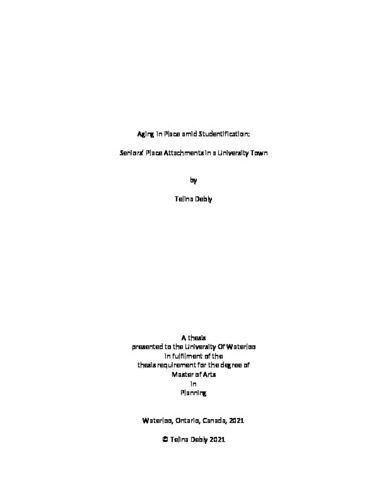| dc.contributor.author | Debly, Telina | |
| dc.date.accessioned | 2021-10-26 19:52:26 (GMT) | |
| dc.date.available | 2021-10-26 19:52:26 (GMT) | |
| dc.date.issued | 2021-10-26 | |
| dc.date.submitted | 2021-10-22 | |
| dc.identifier.uri | http://hdl.handle.net/10012/17674 | |
| dc.description.abstract | Since its formal recognition by the World Health Organization in 2005, the age-friendly planning movement has gained traction and shifted attention towards the diverse needs and experiences of seniors. There is growing acknowledgement that well-being in later life is closely related to one’s physical and social environment, and age-friendly planning now incorporates increasingly sophisticated conceptions of place.
Examining seniors’ place attachments is a corresponding evolution within the literature. Place attachments are emotional bonds that people form to particular physical and social environments. These bonds positively impact older adults’ sense of personal identity, memory, and health. However, place attachments can be negatively impacted by changes in the local environment. One such change is studentification; a process by which a large student population affects an area’s economy, social atmosphere, and physical environment. However, very little existing research examines how a transition towards student-dominated urban public spaces impacts the place attachments of senior residents.
This study addresses the gap in literature by answering the research questions: What place attachment bonds to a city district are demonstrated by long-term senior residents; and how does a large student population affect seniors’ experiences of a city district? Semi-structured long form interviews were conducted with eleven seniors who have lived in the City of Waterloo for
the majority of their lives, and photo-elicitation was utilized to prompt participants to reflect on their experiences amid the growing student population.
Results of this study highlight the importance of long-standing third places for seniors’ affective place attachments, and provide insight into broader senior-student relationships in a city district versus residential neighbourhoods. These findings contribute to establishing a more robust theoretical understanding of older adults’ place attachments, and help to inform the urban planning and engagement practices undertaken by planners and policy makers in university towns. | en |
| dc.language.iso | en | en |
| dc.publisher | University of Waterloo | en |
| dc.subject | place attachment | en |
| dc.subject | studentification | en |
| dc.subject | Uptown Waterloo | en |
| dc.subject | aging in place | en |
| dc.subject | third places | en |
| dc.subject.lcsh | Place attachment | en |
| dc.subject.lcsh | Place attachment | en |
| dc.subject.lcsh | Aging parents | en |
| dc.subject.lcsh | Care | en |
| dc.subject.lcsh | University towns | en |
| dc.subject.lcsh | Waterloo (Ont.) | en |
| dc.subject.lcsh | Waterloo (Ont.: Regional municipality) | en |
| dc.title | Aging in Place amid Studentification: Seniors’ Place Attachments in a University Town | en |
| dc.type | Master Thesis | en |
| dc.pending | false | |
| uws-etd.degree.department | School of Planning | en |
| uws-etd.degree.discipline | Planning | en |
| uws-etd.degree.grantor | University of Waterloo | en |
| uws-etd.degree | Master of Arts | en |
| uws-etd.embargo.terms | 0 | en |
| uws.contributor.advisor | Lewis, John L. (John Llewellyn), 1967- | |
| uws.contributor.affiliation1 | Faculty of Environment | en |
| uws.published.city | Waterloo | en |
| uws.published.country | Canada | en |
| uws.published.province | Ontario | en |
| uws.typeOfResource | Text | en |
| uws.peerReviewStatus | Unreviewed | en |
| uws.scholarLevel | Graduate | en |

